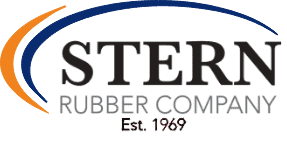Beginning in the early 1960’s, the idea of the snowmobile exploded. Few companies that were manufacturing sleds then are still around today including Coleman, Husqvarna and Sears and Roebuck. Yet one manufacturer that began in Crosby, Minnesota about 45 miles from Staples, and only 20 miles from Stern Rubber’s plant in Aitkin, was a manufacturer by the name of Scorpion.
In the late 50’s, Glen Gutzman and his business partner Donald Bergstrom, were constantly working to build an air powered machine that would propel a driver and a passenger through difficult snow conditions. Glen, and his team, made their first machine in Eagle Bend, Minnesota. As time progressed, Glen’s production of his aluminum bodied machines continued, and he would soon move his production to a small garage that he leased in Crosby, and named his company Trail-A-Sled Mfg (TAS).
Upon his arrival in the Crosby area, Glen met Dick Harrison, and his father, Eugen “Stub” Harrison, local painters, and avid air sled designers. Dick and Stub had been working on an all-aluminum machine of their own, composed of parts from a surplus aircraft fuselage, and designed through trial and error. The three men would soon become partners, upon the resignations of Glen’s previous group members, and the three were a near perfect team. With Glen’s business skills at the forefront, Dick’s mechanical ability working with the engines, and Stub’s meticulous eye designing the body styles, they were destined to make something great.
As the men began to work together, they soon realized their idea of making an aluminum based machine was not in their best interest, and soon switched to working with fiberglass. TAS soon began to build pontoon boats, duck boats, canoes, and even sleeper cabs for semi-trailers, yet their air sled was their constant priority. In 1960, the firm finally unveiled their new machine, and over the course of four years, would produce about 50 air-sleds. The machine featured a Lycoming 125 hp engine, spacious heated interior, and easy towing capabilities that made them very popular in the commercial market.
Although the firm worked hard to design their own machines, they also kept a close relationship with other companies, and acted as a retailer and supplier to Polaris industries. Throughout the early 60’s, TAS also experimented with tracked snow machines, and in 1964 cranked out nearly 50 fiberglass bodied sleds, that featured the popular, but noisy cleated track. Yet as the 1965 model year rolled around, TAS’s big break came along, when the team came up with the idea of using an all rubber track on their new “Scorpion” snowmobile. They soon got it patented, making it the first track to be patented in the United States. The new Scorpion model was a big hit for TAS, and for the 1965 model year, the company produced 500 machines that featured their all rubber track, fiberglass body, and had the capabilities of going 40mph.
With popularity sweeping the company away, they soon needed to become masters of production, and began to expand rapidly, while they still continued to do mainly all of their own production including hoods, seats, windshields, tunnels, and clutches to name a few. This included them doing their own rubber molding for items such as the engine mounts and bogie wheels! That all added to what seemed to be an endless list of production items. As 1967 approached, Scorpions abilities seemed endless, with even Vice President, Hubert H Humphrey stating that “the Central Lakes area is the Official Snowmobile Capital of the World.” By the end of 1967, Scorpions popularity continued, and in February, three Scorpion employees set off on the machines, on a journey from Crosby to Anchorage Alaska. In just a little over 28 days, the men arrived in Anchorage with their machines, and newly invented track still at top performance. The journey north was so popular, that even Sir Edmund Hillary (the conqueror of Mount Everest) chose to use Scorpion snowmobiles in his next expedition.
Check back next week for the rest of the story!
